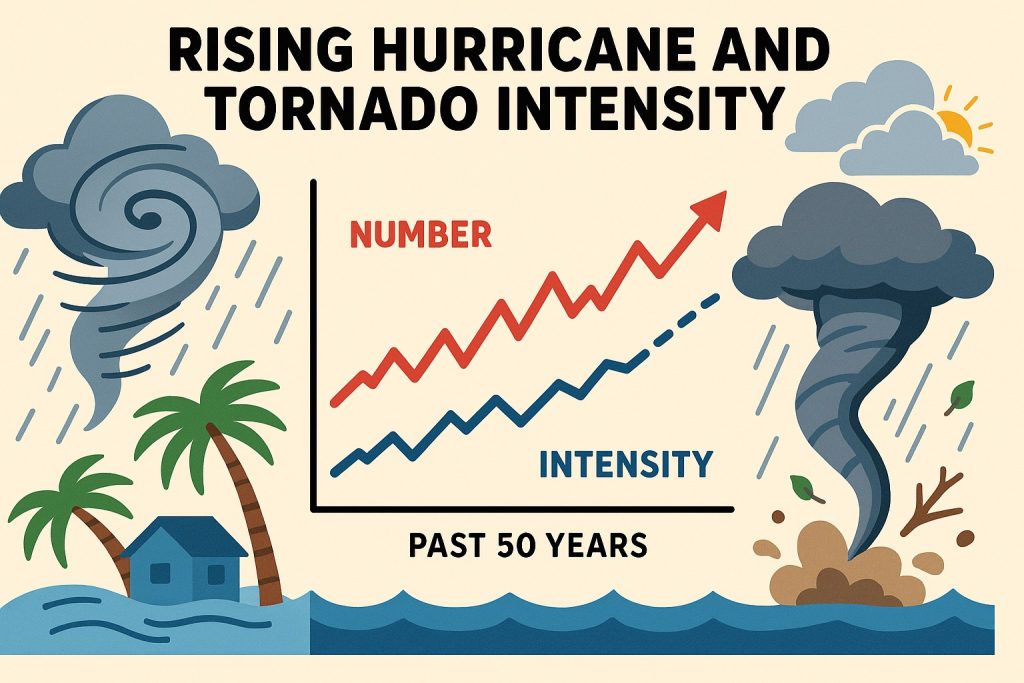In the past five decades, both hurricanes and tornadoes have shown a worrying increase in frequency, strength, and unpredictability. While weather variability is natural, growing scientific evidence suggests that climate change is playing a significant role in amplifying the power and destructiveness of these extreme storms. Understanding the trends and drivers behind these events is critical for disaster preparedness and long-term resilience.
Hurricane Trends: Stronger and Slower
Since the 1970s, hurricanes—also known as tropical cyclones or typhoons in other parts of the world—have become more intense. Key changes include:
- Higher wind speeds: The number of Category 4 and 5 hurricanes has roughly doubled since the 1980s.
- Increased rainfall: Warmer air holds more moisture, leading to heavier downpours and flooding.
- Slower storm movement: Hurricanes are moving more slowly, prolonging exposure to wind and rain in affected regions (e.g., Hurricane Harvey in 2017).
- Longer seasons: The Atlantic hurricane season now begins earlier and ends later than in the past.
Major storms such as Katrina (2005), Sandy (2012), Maria (2017), and Ian (2022) reflect this trend toward mega-hurricanes with devastating consequences.
Tornado Patterns: Greater Variability and Cluster Behavior
Tornadoes—violent, rotating columns of air that touch the ground—have also shown shifting patterns:
- Increased frequency of tornado outbreaks: More tornadoes are now occurring in clusters, with dozens touching down in a single day.
- Shifting geography: While historically concentrated in “Tornado Alley” (Oklahoma, Kansas, Texas), tornado activity has increasingly shifted eastward into the Southeast U.S.
- Stronger events: There has been a rise in EF4 and EF5 tornadoes (the most powerful), often causing catastrophic damage to communities.
- Longer tracks: Some tornadoes now travel farther and last longer, increasing their destructive reach.
Though total yearly numbers may fluctuate, the intensity and impact of tornadoes have clearly risen.
What’s Driving the Rise?
Multiple factors contribute to these growing risks:
- Rising ocean temperatures provide more energy for hurricanes.
- Warming of the atmosphere enhances conditions for both heavy rainfall and tornadic supercells.
- Urban sprawl and deforestation increase the damage potential and exposure of populations.
- Increased data and detection improve storm reporting but also highlight more storms that previously went unrecorded.
Climate scientists agree that anthropogenic climate change is intensifying many features of extreme weather events globally.
Consequences and Adaptation
The rise in hurricane and tornado activity poses major threats to human safety, infrastructure, and economies:
- More deaths and injuries during extreme weather events.
- Escalating insurance losses and property damage.
- Power outages, food shortages, and water contamination after storms.
- Displacement of communities due to repeated disasters.
To adapt, cities must invest in storm-resilient infrastructure, early warning systems, and emergency education programs. Individual households can also play a role by preparing disaster kits and understanding evacuation routes.
Glossary
- Hurricane (or tropical cyclone) — A powerful storm system with high winds, storm surge, and heavy rain.
- Tornado — A violently rotating column of air in contact with the ground, usually during thunderstorms.
- EF Scale — Enhanced Fujita scale, used to measure tornado strength.
- Storm surge — A coastal flood caused by strong winds pushing seawater inland.
- Anthropogenic — Originating from human activity, especially in reference to climate change.


